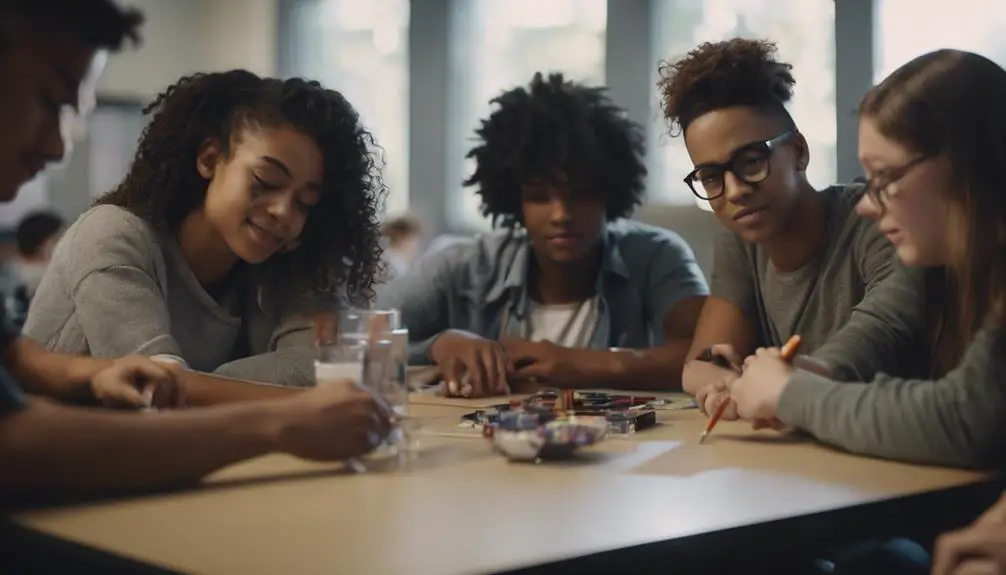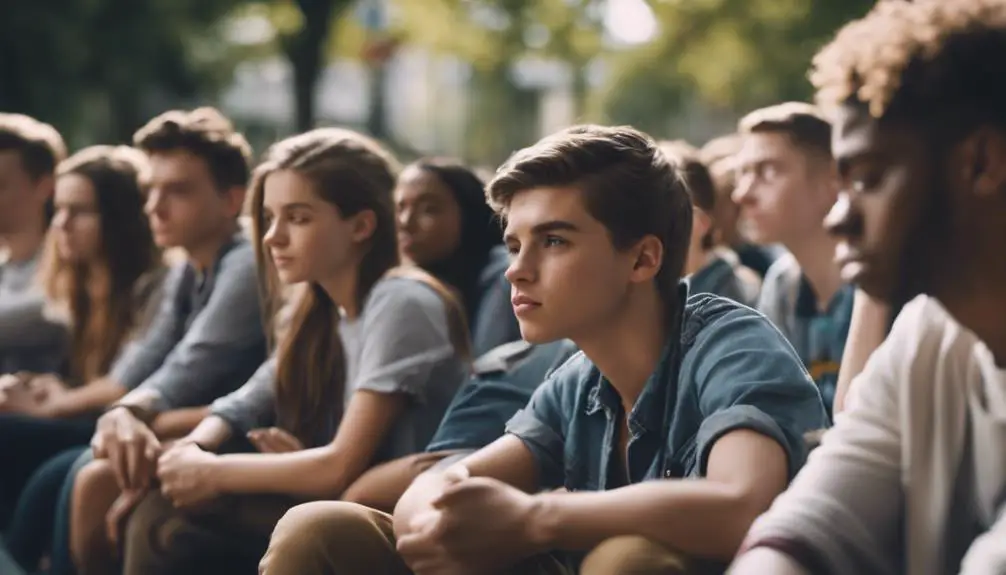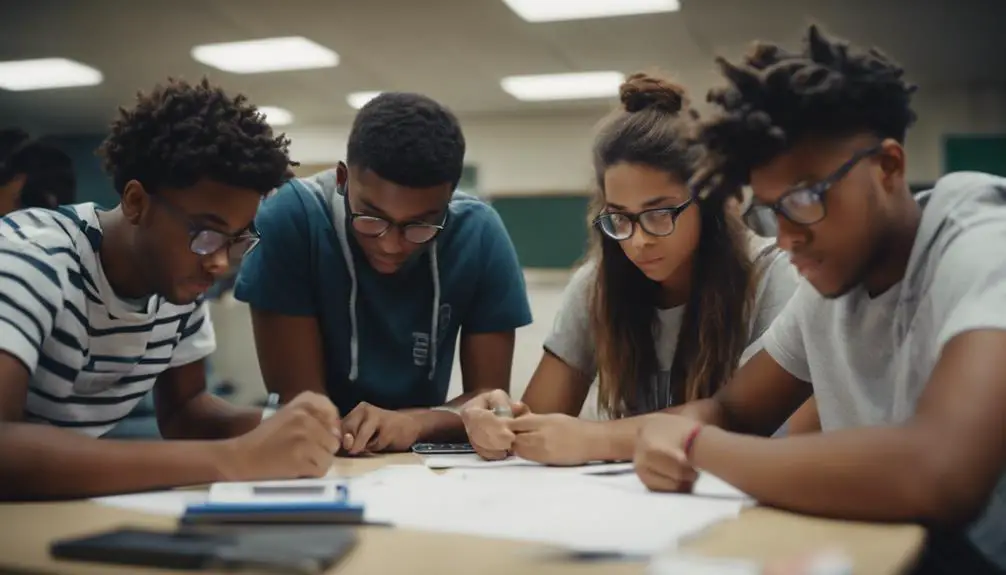Effective group work in student projects can sometimes face challenges when roles are unclear, and communication falters. Proper grouping is essential for successful collaborative efforts.
Balancing skill levels and setting clear expectations are crucial for a positive group work experience.
Let’s discuss the key guidelines to optimize student group dynamics and ensure productive learning outcomes.
Dos For Grouping Students for group work

When grouping students for collaborative tasks, it’s important to have a mix of skill levels in each group. Defining clear roles within the group can help streamline responsibilities and tasks, making teamwork more efficient.
Considering different perspectives, and learning styles, and setting clear expectations are crucial for successful student groupings.
Balanced Skill Levels
When forming student groups for collaborative projects, it’s beneficial to ensure a mix of skill levels among team members. This diversity in abilities can enhance the overall learning experience and promote effective teamwork.
It’s essential to assess each student’s strengths and weaknesses to create balanced groups where task delegation allows for equal participation from all members. Encouraging peer support within these groups can further facilitate learning, as students can assist each other in areas where they may struggle, leading to mutual growth and understanding of the task at hand.
Clear Group Roles
In student groups, it’s essential to assign specific roles to each member to enhance collaboration and productivity effectively. Role clarity is crucial for avoiding confusion, and ensuring everyone knows their responsibilities.
By clearly defining roles based on individual strengths and interests, teams can optimize dynamics and improve workflow efficiency. Delegating tasks strategically, considering each member’s expertise, can enhance overall performance.
Regular check-ins, clear goal-setting, and effective communication are vital to keeping everyone aligned. Additionally, having a plan in place for conflict resolution can prevent disputes and maintain a positive working environment conducive to progress.
Varied Perspectives Encouraged
Diverse backgrounds and viewpoints can have a positive impact on group work dynamics by fostering collaboration. When students from different backgrounds work together, it can lead to increased creativity and improved problem-solving skills. By bringing together individuals with varied perspectives, a wide range of ideas and solutions are introduced, sparking innovative approaches to tasks and projects.
Furthermore, building relationships across diverse backgrounds promotes teamwork and creates a supportive environment for all group members. Embracing varied perspectives in group work allows each member to contribute their unique strengths, resulting in more effective and well-rounded outcomes. By valuing diversity and inclusivity, we can cultivate richer and more dynamic group work experiences.
Consider Learning Styles
When forming groups for collaborative projects, it’s important to consider the diverse learning styles of students. People process information in different ways, so grouping students based on their learning preferences can enhance group dynamics.
Some students are visual learners, understanding concepts better through images and spatial understanding. Others are kinesthetic learners, benefiting from hands-on experiences. Auditory learners excel through listening and verbal instruction.
Set Clear Expectations
When forming student groups for collaborative projects, it’s vital to set clear expectations to ensure smooth cooperation and productivity. Here are some key points to consider:
- Communication guidelines and accountability: Clearly outline how and when group members should communicate progress and challenges.
- Setting boundaries and mutual respect: Establish respectful behavior expectations and personal boundaries to maintain a positive working environment.
- Timely feedback and constructive criticism: Encourage open feedback channels and constructive criticism to help group members improve and grow.
Monitor Group Dynamics
When monitoring group dynamics in collaborative projects with students, it’s essential to implement key strategies for effective teamwork.
Conflict resolution is crucial for maintaining a positive group environment.
Team building activities can help build trust and camaraderie among group members.
Understanding the various communication styles present in the group is important for facilitating productive interactions and idea-sharing.
Observing leadership dynamics within the group can help identify natural leaders who can guide the team toward success.
Implementing peer accountability mechanisms encourages individuals to fulfill their responsibilities within the group.
Provide Support Resources
Regularly providing support resources to students grouped for collaborative projects is crucial for improving their overall group work experience and success. Making sure that resources are available and utilizing support services can significantly impact student collaboration within the group dynamic.
Here are some key points to consider:
- Utilize assistance programs: Providing programs tailored to teamwork strategies can help students overcome challenges effectively.
- Leverage academic resources: Giving students access to academic resources and collaboration techniques can enhance the quality of group projects.
- Offer student support: Ensuring that students have the necessary support can result in improved group project success.
Foster Inclusive Environment
Incorporating inclusive practices is crucial for creating a positive and productive environment when grouping students for collaborative work. Developing empathy among group members is key to understanding different perspectives and experiences, which in turn fosters a safe space where everyone feels valued and heard.
Cultivating trust within the group promotes open communication and the sharing of ideas without fear of judgment. Collaboration is enhanced through inclusivity, allowing each member to contribute their unique strengths towards a shared goal. Respecting one another’s opinions and backgrounds helps cultivate a sense of unity and belonging within the group.
Allow for Flexibility
When organizing students for group projects, it’s valuable to be flexible with roles and responsibilities. Flexibility allows individuals to contribute based on their strengths and interests, which leads to a more efficient and engaged team.
Overcoming challenges through open communication and a willingness to adjust as needed is key. It’s important to consider student preferences to create a comfortable and productive environment where everyone feels valued.
Group dynamics are crucial for collaborative success, and flexibility enables a natural flow of interactions. By allowing room for creativity and innovation within the group, collaboration strategies can be greatly enhanced.
Don’ts For Grouping Students for Group Work

When creating student groups, it’s important to carefully consider each student’s skills and strengths instead of randomly selecting them.
Failure to acknowledge the diversity of abilities within the group can result in imbalanced collaborations and hinder productivity.
Issues like clashes in personalities, unclear role assignments, and allowing dominant individuals to overshadow others can disrupt the group dynamics and impact the overall project’s success.
Random Student Selection
Randomly assigning students to groups without considering their individual strengths and weaknesses can lead to ineffective collaboration and hinder the overall success of group work projects. It’s important to avoid this practice and instead focus on creating groups thoughtfully.
- Random pairing: Assigning students without thought can lead to mismatched skill sets.
- Fair distribution: Ensuring an equal distribution of skills can enhance group performance.
- Student preferences: Considering students’ strengths and weaknesses can lead to more productive and harmonious group dynamics.
Ignoring Skill Diversity
When forming groups for collaborative projects, it’s essential to consider the diverse skills of each student. Assessing skills helps in identifying strengths, weaknesses, and expertise within the team.
By matching tasks to individual skills, delegating responsibilities accordingly, and fostering open communication, teams can work cohesively toward achieving their goals.
It’s important to provide training, encourage teamwork, establish clear goals, and celebrate achievements to enhance project outcomes through effective collaboration strategies.
Overlooking Personality Clashes
When forming student groups for collaborative projects, it’s crucial to consider potential clashes in personalities among team members. Utilizing personality assessments can help pinpoint individual traits, facilitating better team composition.
Engaging in team-building activities can promote understanding and respect within the group, mitigating conflicts. Effective communication strategies, such as active listening and clear communication, play a vital role in preventing disagreements. Additionally, possessing conflict resolution skills is essential for effectively addressing any conflicts that may arise.
Lack of Clear Roles
When roles aren’t clearly defined in student groups working on collaborative projects, it can lead to confusion, inefficiency, and frustration among team members. It’s crucial to clarify roles to establish who’s responsible for specific tasks, which also aids in resolving conflicts. Setting up accountability measures and improving communication strategies helps ensure that everyone understands their role and what’s expected of them.
Developing leadership skills can assist in delegating tasks effectively, and promoting teamwork and trust within the group. Engaging in team-building activities and providing feedback mechanisms can enhance collaboration and strengthen cohesion. With clear roles, problem-solving, and decision-making processes can flow more smoothly, enabling the group to work cohesively, increase productivity, and achieve shared goals effectively.
Allowing Dominant Individuals
When dealing with dominant individuals in student group projects, it’s important to establish a fair and collaborative environment that encourages equal participation from all team members. Dominant personalities can disrupt group dynamics if they overshadow others, so it’s crucial to promote open communication where everyone’s ideas are respected.
Assigning specific leadership roles to different team members can help distribute tasks evenly and prevent one person from taking over. Challenges may arise when dominant individuals overlook the input of others, affecting the group project’s overall success.
Disregarding Communication Preferences
Disregarding communication preferences in group work can lead to misunderstandings and hinder effective collaboration among team members. It is crucial to respect individuals’ communication styles to avoid barriers that may arise. By fostering understanding and addressing concerns related to how team members prefer to communicate, we can enhance collaboration significantly. Here is a table summarizing the importance of respecting communication preferences:
| Communication Barriers | Respect Preferences | Foster Understanding | Address Concerns |
|---|---|---|---|
| Misunderstandings due to mismatched styles | Acknowledge and adapt | Encourage open dialogue | Listen actively and adjust |
Respecting each other’s communication preferences is a simple yet powerful way to ensure smooth communication and successful group work.
Unequal Workload Distribution
When working in a group, it’s crucial to ensure that all team members share the workload equally to promote collaboration and achieve successful results. To achieve this, it’s important to divide tasks fairly based on each member’s strengths and availability. Effective communication plays a key role in making sure everyone understands their responsibilities and can raise any concerns about workload distribution.
Promptly addressing concerns and regularly seeking feedback help identify and resolve any imbalances in workload. Lastly, fostering collaboration among team members creates a supportive environment where individuals can assist each other in balancing the workload effectively.
Neglecting Time Zones
Neglecting time zones in student group work can create significant communication challenges and impede effective collaboration. Coordinating group tasks across different time zones complicates time management. Project progress may be delayed because group members aren’t available simultaneously.
Finding suitable times for virtual meetings where all members can participate becomes challenging due to scheduling conflicts. Additionally, navigating time zone differences can worsen cross-cultural misunderstandings.
To address these issues, establishing clear communication channels, using technology for scheduling, and respecting each member’s time zone constraints are crucial. Proactive management of time zone discrepancies will boost group productivity and cohesion.
Failure to Set Expectations
When working in a group, it can be more difficult if everyone isn’t clear on what’s expected of them. This lack of clarity can lead to confusion and inefficiency.
To prevent this, it’s important to:
- Clearly define each member’s responsibilities and how conflicts will be handled.
- Establish guidelines for communication and behavior while openly discussing and resolving any misunderstandings.
- Outline the group’s objectives and how challenges will be addressed together.
Conclusion
In summary, when it comes to grouping students for collaborative tasks, it’s crucial to keep in mind the dos and don’ts. By adhering to these guidelines, students can enhance their teamwork and achieve better results.
Remember, effective communication and cooperation are vital for success in group assignments. So, next time you’re forming a group, remember these tips to ensure a positive and productive experience for everyone involved.














